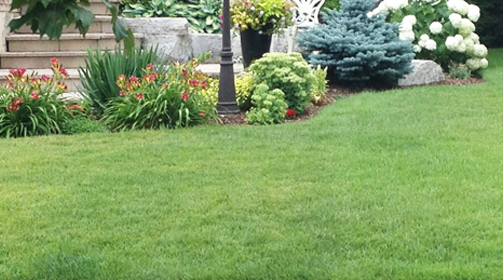Is your lawn being cooked by these boiling hot temperatures?
Hot temperatures and lack of moisture cause lawns to go dormant or begin turning brown. Often times the lawn will recover once the weather conditions improve. However, during this dormant period, the lawn is susceptible to insect and weed invasion. There may also be areas of the lawn that do not come out of dormancy which can create bare spots in your lawn. These areas will need to be overseeded. But! If the soil has been infested with weeds, insects, thatch, or just general wear and tear, make sure you repair the soil before re-seeding.
Follow these fall renovation steps and you will have the best-looking lawn on the block!
- Have your soil tested. A pH that is not neutral can cause many problems in a lawn.
- Dethatch your lawn. Excessive thatch creates an environment for disease and pests.
- Aerate your lawn. More often than not, weeds are found in areas of the lawn that are compacted. Aerating will help relieve this compaction, improve rooting, and decompose thatch.
- Slit-seed your lawn. This will put the seed in direct contact with the soil which allows for a faster and more successful germination rate. Slit-seeding creates a thicker dense lawn that will crowd out the weeds.
Lawn and Landscape Checklist
- Prune shrubs and perennials that have finished blooming for the year
- Pull weeds before they go to seed
- Transplant, divide, and plant perennials such as daylilies, liriope, and coneflowers.
- Fertilize your plants. Do not use high nitrogen fertilizer because you do not want to encourage new foliage growth. Instead, use a fertilizer high in phosphorus and potassium. This will increase the cold hardiness of the plant and create a strong root system. It will also help keep the plant disease resistance.
- Remove any plants that are infected with disease or insects.
Keep Your Eyes Peeled!
If it isn’t heat stressing or burning your lawn, then it could be fungus or insect damage. Brown patch, dollar spot, summer patch, smut, and rust are all fungal diseases that are caused by summer heat. However, these diseases can be confused with drought stress. It is very important that you watch for warning signs before it’s too late. The most common insect damage in August is caused by white grubs. Simply pull up on areas of your lawn. If it pulls up easily, you may want to take a closer look! If you see a white C-shaped grub below the roots, you’ve got a problem! Also, be sure to prevent drought stress damage by using proper watering techniques.
